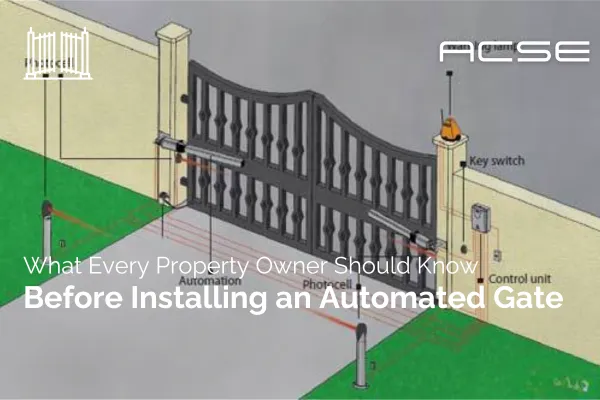
What Every Property Owner Should Know Before Installing an Automated Gate
Automated gates offer a powerful combination of convenience, security, and curb appeal. But while the benefits are clear, the decision to install an automated gate comes with important technical and regulatory responsibilities. Whether you're securing a home, managing a residential community, or upgrading a business entrance, the success of your gate system depends on how well you prepare before installation begins.
This article outlines what every property owner should understand before committing to a gate automation project—helping you avoid costly mistakes, stay compliant, and get the most out of your investment.
Know Your Property’s Layout and Space Requirements
Before selecting a gate design or operator, it’s essential to assess your property’s layout. The space available determines the gate type and operation method.
Driveway width and depth: Is there enough space for a swing or sliding gate?
Obstructions: Are there trees, walls, slopes, or utilities nearby?
Turnaround area: Will vehicles have room to safely enter, wait, and exit?
Pedestrian access: Should you include a separate gate for foot traffic?
A professional site assessment will ensure your gate fits the space and supports safe vehicle and pedestrian movement.
Choose the Right Gate Type for Your Needs
Each gate type has unique space, function, and aesthetic considerations.
Swing Gates: Ideal for flat terrain, but require space to open inward or outward.
Sliding Gates: Great for compact areas or inclined driveways, requiring side clearance.
Vertical Lift or Pivot Gates: Useful in industrial or high-security settings where space is limited.
The right choice depends on your usage patterns, layout, and visual preferences.
Understand Local Codes and Safety Standards
Automated gates must comply with safety regulations to protect people, vehicles, and property.
UL 325: U.S. safety standard requiring entrapment protection devices like sensors and edge guards.
ASTM F2200: Covers gate construction and design features like mesh spacing, structural integrity, and clearances.
Local building or HOA regulations: These may dictate design, access control types, or emergency access requirements.
Failure to comply could result in project delays, fines, or unsafe installations.
Plan for Power Supply and Cabling
Gate automation systems require consistent electrical supply and protected wiring.
Where will the power come from? You may need a dedicated circuit or conduit from the main panel.
Is solar power an option? Solar kits are available for gates in remote or off-grid locations.
Control wiring: Keypads, sensors, loop detectors, and intercoms all require planned routes for cable runs.
Conduits: Underground conduits must be weather-resistant and properly sloped to drain moisture.
Your installer should assess voltage availability and determine whether 24V, 120V, or 240V systems are suitable.
Select the Right Access Control Features
Automated gates can be enhanced with a range of entry systems, depending on your level of control and convenience:
Keypads and remotes: For personal or limited user access
Card readers and fobs: Ideal for businesses or communities with multiple users
Intercom systems: Let users confirm visitor identity before granting access
Smartphone apps: Enable remote opening, tracking, and management
Cameras and license plate recognition: Offer enhanced visibility and automation
Choosing the right system will depend on traffic flow, user behavior, and your security goals.
Budget for More Than the Gate
The gate itself is only part of the total cost. Consider the full scope of a proper installation:
Motor and operator unit
Safety devices and sensors
Access control hardware
Concrete footings and electrical work
Permits, inspections, and code compliance
Ongoing maintenance and service plans
A certified installer will provide a detailed proposal outlining all components and labor to avoid surprises later.
Think About Emergency Access
Your gate must function safely during emergencies or power failures.
Manual release: Allows the gate to be opened manually if needed
Battery backup: Keeps the system operational during outages
First responder access: Devices like Knox Boxes or strobe sensors ensure authorized access for police or fire personnel
Signage and lighting: Important for safe navigation during low visibility or urgent conditions
Planning these features ensures that safety is never compromised, even in a crisis.
Prioritize Safety and Long-Term Support
A gate is a moving machine that interacts with people and vehicles every day. It must be built with safety as a core principle.
Always include at least two entrapment protection devices (required by UL 325)
Use edge sensors, photo eyes, and loop detectors for layered protection
Ensure the operator is rated for your gate’s weight and frequency of use
Work with certified installers trained to follow safety protocols
Choose providers that offer maintenance packages and technical support
Safety isn’t optional—it’s foundational to system performance and liability protection.
Partner with the Right Installer
The most important decision you’ll make is not about the gate—it’s who installs it. A qualified, certified installer brings:
Expert site evaluation
Knowledge of electrical and structural standards
Hands-on experience with access control integration
Ongoing support and service after installation
At ACSE, our team is certified and experienced in designing, specifying, and delivering systems that comply with UL 325 and ASTM F2200 while meeting your property’s unique goals.
Ready to install an automated gate that’s built to last and comply?
Contact ACSE today for a consultation. Our team will help you plan every step of your installation, from layout to compliance to long-term support.
To learn more or schedule a consultation with our design and installation team, send us an email at [email protected].

